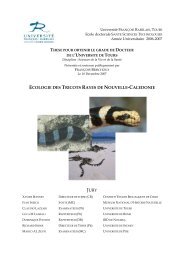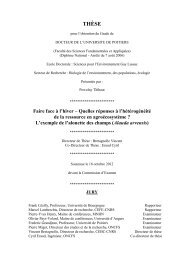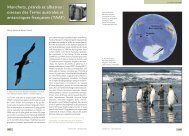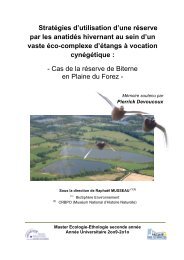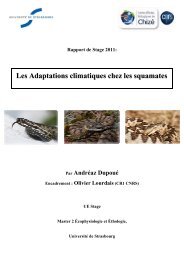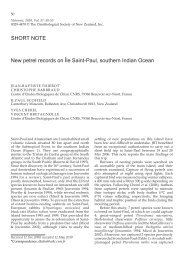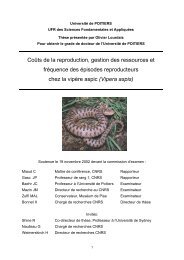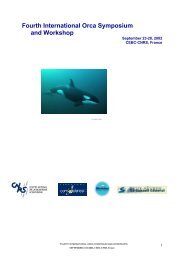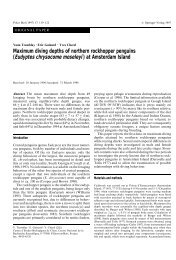Forçage environnemental et prédateurs marins ... - Cebc - CNRS
Forçage environnemental et prédateurs marins ... - Cebc - CNRS
Forçage environnemental et prédateurs marins ... - Cebc - CNRS
You also want an ePaper? Increase the reach of your titles
YUMPU automatically turns print PDFs into web optimized ePapers that Google loves.
Journal of Applied Ecology 2008, 45,<br />
1460–1467 doi: 10.1111/j.1365-2664.2008.01537.x<br />
Blackwell Publishing Ltd<br />
Demographic response of a population of white-chinned<br />
p<strong>et</strong>rels Procellaria aequinoctialis to climate and longline<br />
fishery bycatch<br />
1<br />
Christophe Barbraud *, Cédric Marteau<br />
1<br />
Henri Weimerskirch<br />
2<br />
, Vincent Ridoux , Karine Delord<br />
1<br />
1<br />
2<br />
Centre d’Etudes Biologiques de Chizé, UPR 1934 <strong>CNRS</strong>, 79360 Villiers en Bois, France; and Centre de Recherche sur<br />
les Ecosystèmes Littoraux Anthropisés, UMR 6217 <strong>CNRS</strong>-IFREMER-Université La Rochelle, Avenue Michel Crépeau,<br />
17042 La Rochelle, France<br />
Summary<br />
1. Fisheries can affect non-targ<strong>et</strong> species through bycatch, and climate change may act simultaneously<br />
on their population dynamics. Estimating the relative impact of fisheries and climate on<br />
non-targ<strong>et</strong> species remains a challenge for many populations because the spatio-temporal distribution<br />
of individuals remains poorly known and available demographic information is incompl<strong>et</strong>e.<br />
2. We used population survey data, capture–mark–recapture m<strong>et</strong>hods, population modelling and<br />
the demographic invariant m<strong>et</strong>hod to investigate the effects of climate and fisheries on the demography<br />
of a predator species affected by bycatch. These complementary approaches were used to<br />
help account for different sources of uncertainty.<br />
3. The white-chinned p<strong>et</strong>rel Procellaria aequinoctialis is the commonest seabird species killed by<br />
longline fisheries in the Southern Ocean. P<strong>et</strong>rel breeding success was positively related to the fishing<br />
effort for Patagonian toothfish Dissosticus eleginoides.<br />
El Niño events negatively affected adult<br />
survival with a time lag of 3 years. Fishing efforts for toothfish and hake ( Merluccius spp.) were negatively<br />
related to p<strong>et</strong>rel recruitment, suggesting that fisheries-induced mortality strongly impacted<br />
younger age classes. Lambda estimated from matrix population models was below replacement<br />
(0·964 ± 0·026), and the number of breeding pairs declined by ≈ 37% in 21 years. This decline was<br />
probably caused by low survival of both young age classes and adults.<br />
4. The Croz<strong>et</strong> archipelago, Southern Indian Ocean, population size was estimated at ≈ 170 000<br />
individuals in the early 1980s, and would be severely affected by any additional source of mortality<br />
that approached 8000 individuals per year. The number of p<strong>et</strong>rels killed by the toothfish fishery<br />
alone exceeded this threshold during the late 1990s and early 2000s, but has declined well below<br />
this since 2003.<br />
5. Synthesis and applications.<br />
Complementary approaches suggest that both longline fishery bycatch and<br />
climate have a significant impact on the size of the Southern Ocean white-chinned p<strong>et</strong>rel population.<br />
Stopping or reversing climate change will be a very slow process, and may be impossible.<br />
Therefore, we recommend a reduction in bycatch to help the populations recover. Further information<br />
on the status of individuals caught in longlines is required to understand the demographic processes<br />
involved.<br />
Introduction<br />
Key-words: survival, demographic invariants, El Niño, longline fishing, population model,<br />
Procellaria aequinoctialis,<br />
recruitment<br />
Increasing industrialization of fisheries and expansion into<br />
new areas have resulted in intense harvesting of fish stocks,<br />
*Correspondence author. E-mail: barbraud@cebc.cnrs.fr<br />
© 2008 The Authors. Journal compilation © 2008 British Ecological Soci<strong>et</strong>y<br />
1<br />
and<br />
alteration of the structure and functioning of marine ecosystems<br />
(Jackson <strong>et</strong> al.<br />
2001; Pauly <strong>et</strong> al.<br />
2002), and increasing<br />
numbers of marine vertebrates becoming entangled or<br />
hooked accidentally by fishing gear intended for commercial<br />
targ<strong>et</strong> species (Lewison <strong>et</strong> al.<br />
2004). This bycatch has been<br />
implicated in population declines of several species of



